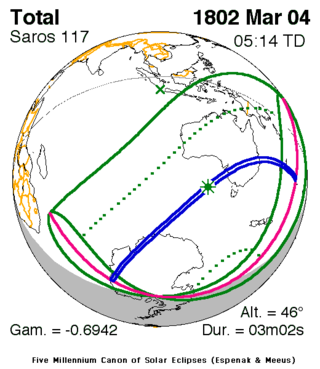| Solar eclipse of March 4, 1802 | |
|---|---|
| Type of eclipse | |
| Nature | Total |
| Gamma | −0.6943 |
| Magnitude | 1.0428 |
| Maximum eclipse | |
| Duration | 182 s (3 min 2 s) |
| Coordinates | 44°00′S 131°30′E / 44°S 131.5°E |
| Max. width of band | 196 km (122 mi) |
| Times (UTC) | |
| Greatest eclipse | 5:14:29 |
| References | |
| Saros | 117 (57 of 71) |
| Catalog # (SE5000) | 9045 |
A total solar eclipse occurred at the Moon's ascending node of orbit on Thursday, March 4, 1802, with a magnitude of 1.0428. A solar eclipse occurs when the Moon passes between Earth and the Sun, thereby totally or partly obscuring the image of the Sun for a viewer on Earth. A total solar eclipse occurs when the Moon's apparent diameter is larger than the Sun's, blocking all direct sunlight, turning day into darkness. Totality occurs in a narrow path across Earth's surface, with the partial solar eclipse visible over a surrounding region thousands of kilometres wide. Occurring about 1 day after perigee (on March 3, 1802, at 4:20 UTC), the Moon's apparent diameter was larger.[1]
The path of totality was visible from parts of modern-day Antarctica, Australia, and Vanuatu. A partial solar eclipse was also visible for parts of Antarctica, Australia, Indonesia, and Oceania.[2]
- ^ "Moon Distances for London, United Kingdom, England". timeanddate. Retrieved 28 September 2024.
- ^ "Solar eclipse of March 4, 1802". NASA. Retrieved June 15, 2012.
